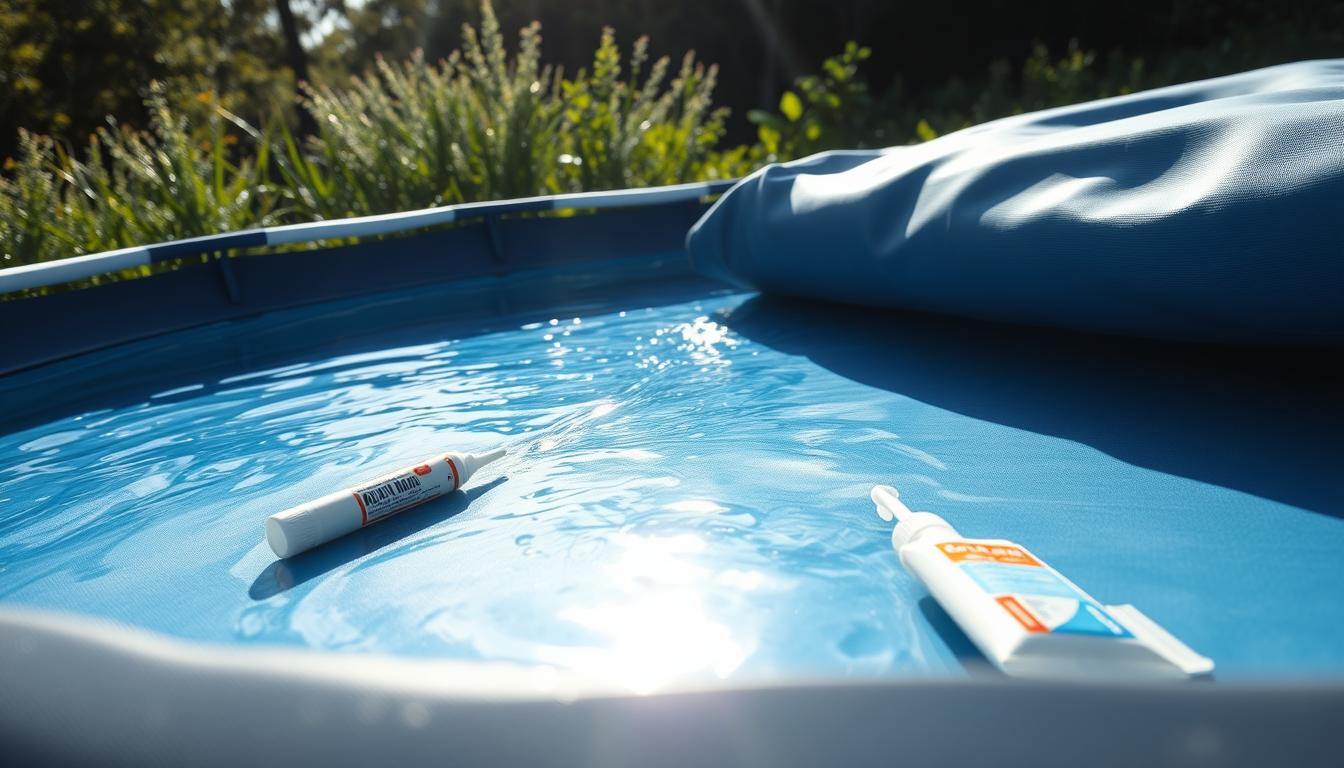
Is your above ground pool losing water too fast? A leaking pool liner can be frustrating and costly. Don’t worry, finding a leak isn’t hard. With simple steps, you can locate and fix pool liner holes quickly.
DIY repairs for minor pool leaks can cost as little as $20 to $50. However, ignored leaks can lead to more serious damage. This includes sinkholes and foundation shifts, which may cost over $1,000 to fix.
It’s important to address leaks as soon as you notice signs. Quick action can save you money and prevent further damage.
We’ll show you how to find leaks in above ground pool liners. You’ll learn about signs to watch for and tools you’ll need. We’ll also provide step-by-step instructions for locating and repairing leaks.
Key Takeaways
- Significant pool water loss exceeding half an inch per day indicates a likely leak.
- Inspecting the liner for visible tears or holes is a crucial step in leak detection.
- Using food coloring or leak detection dye can help pinpoint the location of the leak.
- Small leaks in vinyl liners can typically be patched with a vinyl patch kit designed for underwater use.
- Hiring a professional for leak detection and repair can cost between $200 to over $1,000, depending on the severity of the issue.
Identifying Signs of a Leaking Above Ground Pool Liner
Pool owners need to spot leaks early. Experts say 1 in 20 pools leak, causing water waste and higher costs. Knowing the signs helps us act fast and avoid damage.
Water Level Drops Unexpectedly
A sudden water level drop is a clear leak sign. If levels fall faster than normal, we likely have a leak. Pool leaks can waste up to 14,000 gallons yearly.
Regular water level checks help us spot changes quickly. This allows us to find and fix leaks promptly.
Wet or Soggy Spots Around the Pool
Wet areas near the pool may indicate a leaking liner. Look for damp patches on the ground or deck. These spots might show up after rain or long pool use.
Ignoring these signs can lead to bigger issues. The pool’s structure could be damaged, or mold might grow.
Visible Damage to the Pool Liner
Check the liner for cracks, tears, or holes. Pay attention to seams, fittings, and the pool’s edge. Even small holes can cause gradual water loss.
Bestway’s pools have a Tritech™/DuraPlus™ liner. It’s 83% more puncture resistant and 33% more stretch resistant than standard PVC liners.
| Sign of Leak | Potential Cause | Action Required |
|---|---|---|
| Unexpected Water Level Drop | Hole or tear in liner | Locate and patch the leak |
| Wet or Soggy Spots | Water seeping from liner | Identify the source and repair |
| Visible Liner Damage | Punctures, cracks, or tears | Patch or replace the liner |
Stay alert to these signs and fix leaks quickly. This keeps our pool liner in good shape. Regular maintenance and fast troubleshooting help extend the liner’s life.
These steps can reduce the need for costly liner replacements. They also ensure a safe and fun swimming experience.
How to Find Leak in Pool Liner Above Ground
Suspect your above ground pool is losing water? Several methods can help you detect leaks. Simple tests and inspections can pinpoint the source of the problem. You can then tackle the repair yourself.
Performing the Bucket Test
The bucket test helps confirm if water loss is due to a leak. Fill a bucket with pool water and place it on a step. Mark water levels inside and outside the bucket.
Check the levels again after 24 hours. If the pool lost more water than the bucket, you likely have a leak.
Using Food Coloring or Leak Detection Dye
Food coloring or special pool leak detection dye can locate the exact leak spot. Squirt a small amount near suspected areas like the skimmer, pump, or drain. The dye will flow towards the leak, helping you focus your repair efforts.
Inspecting the Liner for Visible Tears or Holes
Carefully check your vinyl pool liner for tears, punctures, or holes. Focus on seams and corners, as these areas often get damaged. Found a leak? Patch it easily with a vinyl repair kit.
Checking the Pool Equipment for Leaks
Examine your pool equipment for any signs of water leakage. This includes the filter, pump, heater, and pipe valves. Water escaping from these parts may indicate a leak requiring professional attention.







